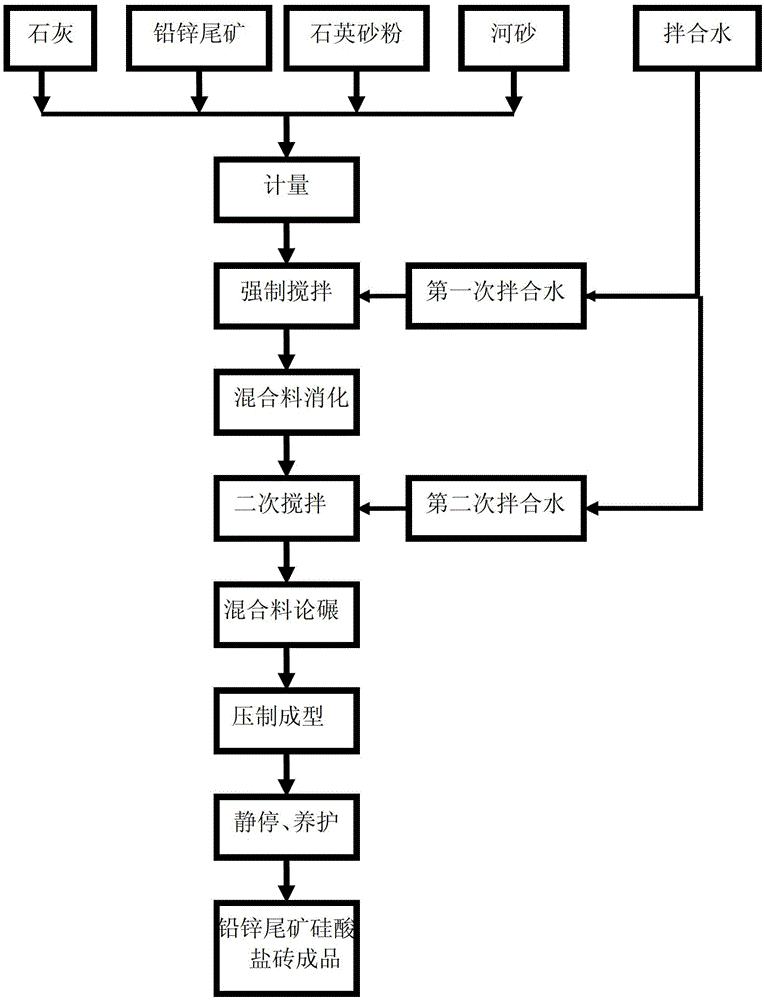Method of manufacturing silicate bricks with lead-and-zinc tailings
A silicate, tailings technology, applied in sustainable waste treatment, solid waste management, climate sustainability, etc., to achieve the effect of improving compactness, increasing content, and high-pressure molding density
- Summary
- Abstract
- Description
- Claims
- Application Information
AI Technical Summary
Problems solved by technology
Method used
Image
Examples
Embodiment 1
[0040] Embodiment 1: the mixture ratio is shown in Table 3
[0041] Table 3 Embodiment 1 Mixture ratio
[0042]
[0043] Step 1: Mixture Preparation
[0044] Put 14 kg of lime, 10 kg of quartz sand powder, 66 kg of lead-zinc tailings, 10 kg of river sand and 5 kg of half of the mixing water into a forced mixer and stir for 4-8 minutes until the materials are mixed evenly and become wet Stirring is stopped during the state, and the mixture is obtained;
[0045] Step Two: Mixture Digestion
[0046] Leave the mixture for 3-6 hours to allow the lime to be fully digested. When the temperature of the mixture reaches the highest temperature (60-70°C), the lime digestion is complete.
[0047] The third step: the second mixing of the mixture
[0048] Add 5 kg of the remaining half of the mixing water to the digested mixture and put it into a forced mixer and stir for 2-4 minutes.
[0049] Step Four: Grinding the Mixture
[0050] The agglomerated mixture is rolled and compacted...
Embodiment 2
[0057] Embodiment 2: See Table 4 for the mixture ratio.
[0058] Table 4 Embodiment 2 Mixture ratio
[0059]
[0060] Step 1: Mixture Preparation
[0061] Put 17 kg of lime, 15 kg of quartz sand powder, 53 kg of lead-zinc tailings, 15 kg of river sand and 5.5 kg of half of the mixing water into a forced mixer and stir for 4-8 minutes until the materials are mixed evenly and become wet Stirring is stopped during the state, and the mixture is obtained;
[0062] Step Two: Mixture Digestion
[0063] Leave the mixture for 3-6 hours to allow the lime to be fully digested. When the temperature of the mixture reaches the highest temperature (60-70°C), the lime digestion is complete.
[0064] The third step: the second mixing of the mixture
[0065] Add 5.5 kg of the remaining half of the mixing water to the digested mixture and put it into a forced mixer and stir for 2-4 minutes.
[0066] Step Four: Grinding the Mixture
[0067] The agglomerated mixture is rolled and compacted ...
Embodiment 3
[0074] Embodiment 3: See Table 5 for the mixture ratio.
[0075] Table 5, embodiment 3 mixture ratio
[0076]
[0077] Step 1: Mixture Preparation
[0078] Put 20 kg of lime, 15 kg of quartz sand powder, 45 kg of lead-zinc tailings, 20 kg of river sand and 6 kg of half of the mixing water into a forced mixer and stir for 4-8 minutes until the materials are mixed evenly and become wet Stirring is stopped during the state, and the mixture is obtained;
[0079] Step Two: Mixture Digestion
[0080] Leave the mixture for 3-6 hours to allow the lime to be fully digested. When the temperature of the mixture reaches the highest temperature (60-70°C), the lime digestion is complete.
[0081] The third step: the second mixing of the mixture
[0082] Add 6 kg of the remaining half of the mixing water to the digested mixture and put it into a forced mixer and stir for 2-4 minutes.
[0083] Step Four: Grinding the Mixture
[0084] The agglomerated mixture is rolled and compacted t...
PUM
 Login to View More
Login to View More Abstract
Description
Claims
Application Information
 Login to View More
Login to View More - R&D
- Intellectual Property
- Life Sciences
- Materials
- Tech Scout
- Unparalleled Data Quality
- Higher Quality Content
- 60% Fewer Hallucinations
Browse by: Latest US Patents, China's latest patents, Technical Efficacy Thesaurus, Application Domain, Technology Topic, Popular Technical Reports.
© 2025 PatSnap. All rights reserved.Legal|Privacy policy|Modern Slavery Act Transparency Statement|Sitemap|About US| Contact US: help@patsnap.com



